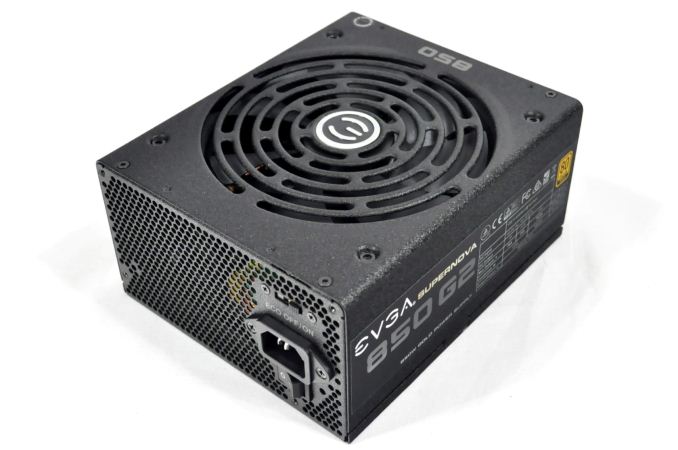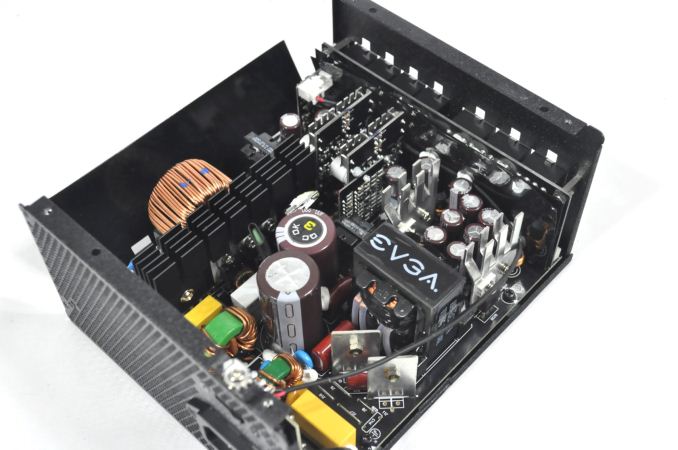EVGA Supernova 850 G2 Power Supply Review
by E. Fylladitakis on May 30, 2014 6:00 AM EST- Posted in
- Cases/Cooling/PSUs
- PSUs
- EVGA
- Super Flower
External Appearance
EVGA clearly made a serious effort to make the Supernova 850 G2 aesthetically unique. Instead of using a typical fan guard, the company went with a modified cover that has a circular-pattern opening integrated, as well as rounded edges. Stickers with the model and its specifications cover both sides of the chassis. The top side of the chassis is all clear, with the exception of two small stickers with the unit's serial and part numbers.
A textured, dark grey paint has been used for the entire unit. The chassis of the power supply is 180mm long, which could be a problem in tight mid-tower cases. As this is a fully modular unit, the front side is littered with the connectors for the cables. There is a legend indicating which connector goes where and we should note that the eight pin CPU connectors are different than the eight pin PCI Express connectors. The rear of the chassis is pretty much standard, with the exception of the "ECO on/off" switch that allows the user to switch between the standard and a more aggressive cooling profile.
Internal Design
EVGA installs a 140 mm dual ball bearing fan from Globe inside the Supernova 850 G2. Although this is a very powerful and notoriously loud model with a maximum speed of 1800 RPM, thankfully it will not even start when the unit is lightly loaded due to the smart "ECO" thermal control. The ECO fan control is based on temperature rather than load, starting the fan once the sensor reads a temperature of 55 °C and stopping it when the temperature drops below 45 °C.
EVGA entrusted the Supernova 850 G2 to Super Flower, a very reputable ODM of high performance PSUs. It is based on the Leadex platform, a design that became very popular for combining high performance and reliability at a reasonable cost.
The filtering stage of the unit is very basic, with two Y capacitors, two X capacitors and two filtering inductors on the main board. There is a small PCB behind the AC receptacle but it has no components soldered on it. Two extra Y capacitors can be found after the primary rectifying bridge, which is rather odd for a switching PSU. The primary rectifying bridge is mounted on the large black heatsink, alongside the active parts of the APFC circuit. As the rest of the heatsinks are much smaller, it can be clearly derived that the majority of the unit's losses originate before the primary inversion stage.
The passive components of the PFC are two Nippon Chemi-Con 330 μF capacitors and a large inductor. Nippon Chemi-Con supplies all of the smaller capacitors as well, electrolytic and polymer alike. Six transistors convert the main transformer's output to a single 12 Volt line and the lower voltage lines are being derived from it with DC to DC conversion circuits.
The assembly quality of the Supernova 850 G2 is very good, but not really perfect. There is enough glue to improve the mechanical cohesion of the unit but not really a lot of it on the large inductors, which can make this model prone to high frequency vibrations (coil whine noise). The soldering job is good, yet not textbook, with some crude joints and uneven use of solder.























22 Comments
View All Comments
NvidiaWins - Thursday, June 25, 2015 - link
Using a HX850 watt gold, this would be a good replacement@129$tazmo8448 - Monday, July 27, 2015 - link
Nice photos of the box and what it looks like out of the box but wheres the test data and a photo with the lid off so we can peek inside to see the 'guts?' do they really use Nippon capacitors? is the fan bearing sleeved (think bushing) or ball bearing? the 850 G2 review did this, was this review done on Fri afternoon? C'mon man give us the meat and potatoes so we can make a choice not just a laydown of the components in HD.